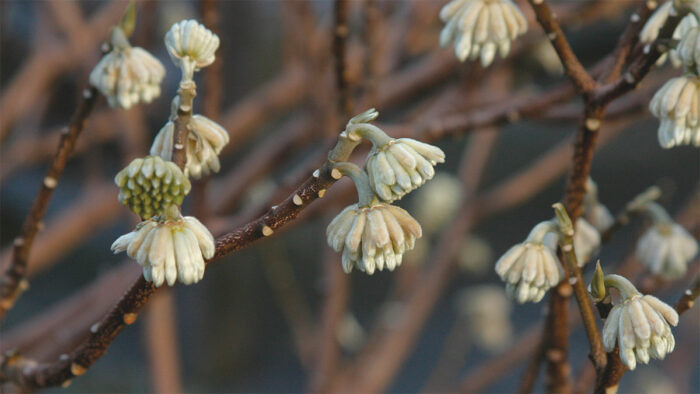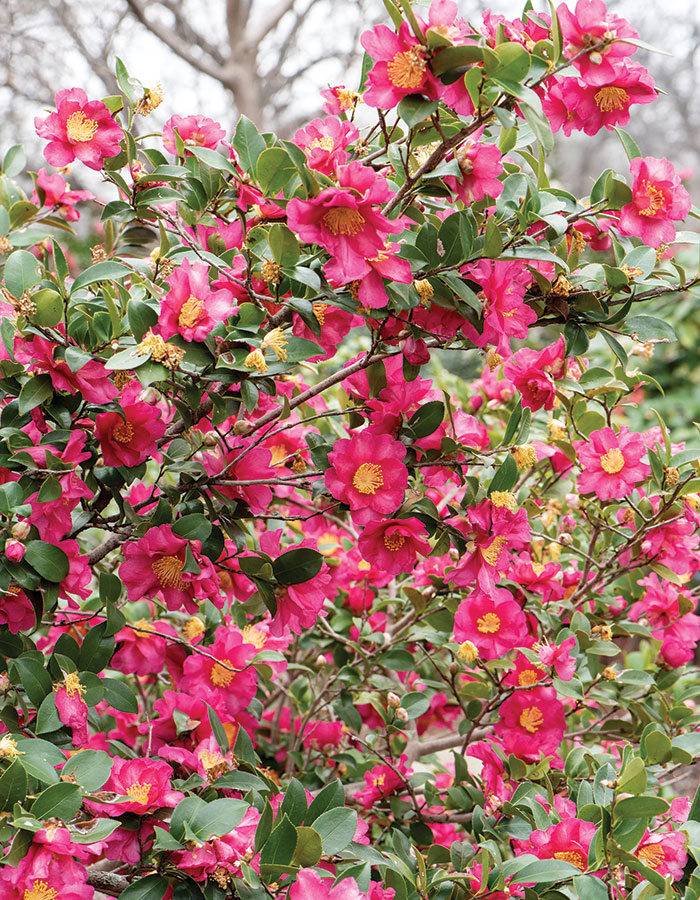
Shade in the garden might seem like a limitation, but the seasoned gardener knows this is just an opportunity to utilize plants that would wilt in a sunny spot.
As Andrew Bunting says in his article on shrubs for shade, there are plenty of options for bringing interest to your shade garden: “If you take a dim view of the shady spots in your garden, it may be because you haven’t found the right plants to make those areas shine. A few well-chosen shrubs can transform a shadowy area into a showcase, and there are more choices available than you might imagine.”
Find four picks for the South below, and find even more shrubs for shade in Andrew’s article, 9 Great Shrubs for Shade.
1. Fall-Blooming Camellia

Name: Camellia sasanqua
Zones: 7–9
Size: 4 to 10 feet tall and wide
Conditions: Morning sun to full shade; moist, organic, well-drained soil
Native range: Japan
Fall-blooming camellias are a spectacular way to add more color to the autumn shade garden. Blooms appear from early fall to early winter set amid lustrous, dark evergreen leaves that highlight the white, pink, or red flowers. With smaller leaves and overall size than spring-blooming camellias (Camellia japonica, Zones 7–9), and with several dwarf varieties available, these abundant bloomers are better adapted for use in smaller gardens and foundation plantings.
2. Japanese Plum Yew

Name: Cephalotaxus harringtonia cvs.
Zones: 6–9
Size: 2 to 10 feet tall and wide; may slowly reach 20 to 30 feet
Conditions: Partial to full shade; medium to low moisture; well-drained soil
Native range: Japan, China, Korea
This lovely evergreen tolerates deep shade, hot weather, and deer. Its short, dark green needles are arranged in a V-pattern along erect stems, giving it a fernlike appearance that combines well with other plants. There are cultivars to suit a variety of needs: ‘Duke Gardens’ has a spreading, mounded habit, ‘Fastigiata’ (pictured) is columnar, ‘Korean Gold’ is columnar with gold tips, and ‘Prostrata’ has a low, spreading habit.
3. Paperbush

Name: Edgeworthia chrysantha
Zones: 7–10
Size: 8 feet tall and wide
Conditions: Partial shade; medium to low moisture; well-drained soil
Native range: China
For terrific multiseason interest, paperbush is a must-have for the Southern garden. This deciduous shrub puts on a winter show, with large, silvery white flower buds capping attractive brown branches (pictured). The buds burst open in late winter to reveal wonderfully fragrant, umbrella-shape flower heads, each one holding around forty tubular yellow flowers that resemble tiny paper scrolls. Attractive, large, medium green leaves appear once the blooms have faded.
4. ‘Wheeler’s Variety’ Butcher’s Broom

Name: Ruscus aculeatus ‘Wheeler’s Variety’
Zones: 7–9
Size: 3 feet tall and wide
Conditions: Partial to full shade; average to dry, well-drained soil
Native range: Europe and western Asia
If you need a tough evergreen shrub for dry shade and heavy root competition, this is the plant for you. Historically used in Southern gardens as a substitute for boxwood (Buxus spp. and cvs., Zones 5–9), this unique evergreen produces dense clumps of upright stems with dark green “foliage” (actually modified stems) that can be used in fl oral arrangements. ‘Wheeler’s Variety’ is self-fertile, producing bright red berries from early fall through winter without needing a pollinator.
Valerie Jones Hinesley is a landscape architect and second-generation owner of Piccadilly Farm Nursery and Gardens in Bishop, Georgia.
Fine Gardening Recommended Products

Scotts Cordless Grass-Shear/Shrub-Trimmer Combo
Fine Gardening receives a commission for items purchased through links on this site, including Amazon Associates and other affiliate advertising programs.

DeWalt Variable-Speed Cordless Reciprocating Saw with 6-Piece Saw Blade Set
Fine Gardening receives a commission for items purchased through links on this site, including Amazon Associates and other affiliate advertising programs.

DeWalt Variable-Speed Cordless Reciprocating Saw
Fine Gardening receives a commission for items purchased through links on this site, including Amazon Associates and other affiliate advertising programs.


















Comments
Log in or create an account to post a comment.
Sign up Log in